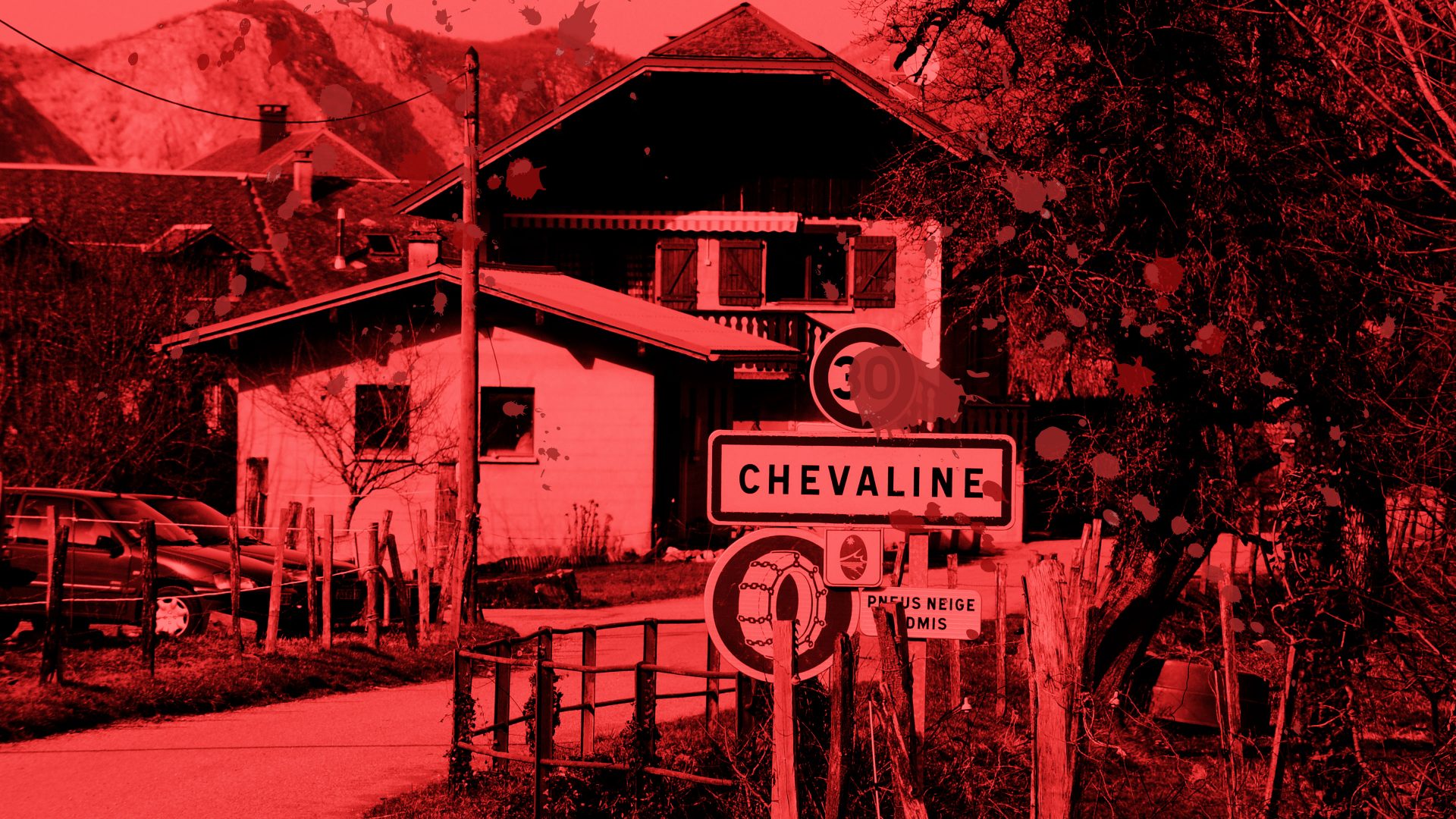Ten years ago a British family drove with their caravan from Claygate in Surrey to the shores of Lake Annecy in the French Alps. On Wednesday, September 5, 2012, an unseasonably hot day, they set out for a drive in the mountains.
Saad al-Hilli, 50, an Iraqi-born micro-satellite engineer, asked his seven-year-old daughter, Zainab, if she wanted to go shopping or walking. She chose to go for a stroll. The Hillis left their caravan by the lakeside, piled into their wine-coloured BMW and made for a popular forest track near the pretty village of Chevaline.
Just before they got there, the Hilli family – Saad, his wife, Iqbal, 47, a dentist, and their little girls, Zainab and Zeena, aged seven and four – posed for a series of smiling photographs. The camera was held by Iqbal’s mother, Suhaila al-Allaf, 74, who was visiting from her home in Sweden. Within half an hour the three adults were dead, each shot twice in the head.
Their car was discovered in a carpark, high up in the 7,000ft high Bauges Massif by a British cyclist. Its wheels were spinning. Saad’s lifeless foot was still on the accelerator. His wife and mother-in-law were slumped in the back seat. A local cyclist, Sylvain Mollier, 48, lay dead beside the car. He had been shot five times.
Zainab, wounded in the shoulder and then beaten over the head with the butt of a revolver, was staggering nearby. Her little sister, Zeena, had hidden and then slept under the skirts of her dead mother. She was found alive eight hours later.
Ten years on, the “al-Hilli” or “Chevaline” murders remain a profound mystery, an object of fascination, in both France and Britain, and a frequent subject for media speculation (and sometimes pure invention). The killings have been variously ascribed to the SAS, the CIA, Israeli intelligence, Iraqi agents, Saddam Hussein loyalists, a gang of cut-price professional killers from eastern Europe and a jealous lover (targeting the French cyclist).
For several months in 2012-13, French and British investigators thought that the killings might be linked to a dispute between Saad al-Hilli and his brother, Zaid, over their father’s will. Zaid, questioned by Surrey police, angrily denied that he had anything to do with the quadruple murder. That line of inquiry was soon dropped. In truth, it was always difficult to see how anyone could have planned the massacre.
Both the al-Hillis and the French cyclist, Mollier, chose their destination that afternoon at random. No one was seen following them. How could the killer have known that they would be at that place at that time?
The murder weapon was a 70-year-old (at least) Luger, which seems to have jammed and/or fallen apart in the killer’s hands. An antique gun is an implausible choice for a hit-man, however cut-price.
For more than a year, French investigators, intrigued and maybe intoxicated by the convoluted, international connections of the Hillis, refused to accept the obvious. All the evidence pointed to a random murder by a local person with an unknown motive — or no motive at all. Until the end of 2013 the French investigator followed the local leads, but insisted that the answer would be found abroad and probably in Britain.
After two routine changes of the chief prosecutor in the Annecy area, “local and random” is now the official, working hypothesis. A summary note of the investigation file, running to several thousand pages, reads, in gendarmerie-speak: “Several explanations can be envisaged but an isolated, local act is currently the favoured direction of the inquiry.”
Even that theory jars with some of the known facts. The murderer fired 21 shots in around 90 seconds. He skilfully and rapidly re-loaded his ancient gun twice. He accurately dispatched the Hilli adults with two shots to the head. Such behaviour resembles that of a professional killer.
He also fired four wild shots. He failed (for reasons unknown) to finish off seven-year-old Zainab. He did not realise that there was a fifth person in the car, four-year-old Zeena. Such behaviour resembles that of a psychopath.
Zainab, now 17, has recovered from her brutal injuries and lives with her mother’s relatives in England. In June last year, she asked to speak to Surrey police. She said she now had a much clearer recollection of what had happened at around 3.30pm on September 5, 2012.
The teenager recalled that her father had given her the choice that day between a walk and a shopping expedition. Moments after she and her father stepped from their car at the forest lay-by, shots were fired. Her mother and father screamed at her to get back into the front passenger seat.
Before she could react, she was seized from behind. She thought that it must be her father until she saw that the man’s hands were white, not brown. He was wearing leather trousers and a leather jacket like those worn by motorcyclists.
Zainab’s recovered memories were helpful but led to no breakthrough. After an elaborate recreation of the events for the ninth anniversary last September, French investigators arrested, for a second time, a Lyon businessman, “Pierre C”, 58, who had been seen riding a motorbike near the murder scene that afternoon. After a two-day interrogation, he was cleared – for a second time – and released without charge.
There has been criticism over the years in the British media of the performance of the French police (or more accurately, the Gendarmerie Nationale, the paramilitary force that polices rural areas in France). There were some early mis-steps but the investigation has otherwise been exhaustive and exhausting. Hundreds of mobile phone calls, guns and witnesses and potential suspects have been traced. Scores of local people have been questioned and five have been held in detention for extended periods as possible suspects. All have been cleared. One of the suspects later committed suicide.
The murders remain as baffling and as intriguing as they were 10 years ago. Most of the outlandish theories only work if you exclude, or marginalise, the facts. So what are the facts? The following is a timeline based on several visits to the murder scene, official statements, reliable leaks from the investigation and interviews given over the years by, among others, William Brett Martin, the former RAF pilot who stumbled on the massacre.
It all happened in the space of 31 minutes. The last family photo found in Suhaila al-Allaf’s camera was taken at 3.17pm in the hamlet of Arnand, 4km from the crime scene. The first emergency call, made by a group of hikers alerted by the British cyclist, William Brett Martin, was made at 3.48pm.
The murders are believed to have occurred between 3.30pm and 3.35pm. If the Hillis drove directly from Arnand to the forest car-park in the Bauges Massif, they would have taken about 12 minutes. They would have arrived at the Martinet car-park, at the end of the narrow and bumpy Route de la Combre d’Ire, at 3.29pm.
This is consistent with Zainab’s memory that shots were fired as soon as she and her father left the car. It is also consistent with Brett Martin’s recollection that he was overtaken by the Hilli car when he was about half-way up the Combe d’Ire track at around 3.25pm.
He saw no cars or motorbikes following the dark-maroon BMW.
A few minutes later – at around 3.30pm – Brett Martin was passed in the other, downhill direction by a four-wheeled vehicle, believed to have been a forestry truck, and soon afterwards by a motorcycle, which slowed as it approached him and then continued in no particular hurry.
Was the murderer riding that bike? Or did both truck and bike pass the murder scene before the Hillis and Mollier arrived there?
Sylvain Mollier was a foreman welder in a local plant supplying metal to the nuclear industry – not a “nuclear scientist” as claimed in some reports. He was on a random cycle ride on a €5,000 (£4,270) racing bike and is not known to have taken that route before.
Brett Martin was overtaken by him at the foot of the winding 3km climb to Martinet at around 3.15pm. He saw no car or motorbike following the Frenchman.
Mollier is known to have been alive at 3.28pm. He broke off from his daily cycle ride to answer a mobile call about childcare from his ex-wife. He seemed breathless but otherwise normal. Within a few minutes, he was dead.
Zainab’s evidence, along with feet and tyre marks and the location of bullets and cartridges at the murder scene, has allowed French investigators to establish the following sequence of events with what they describe as “80% to 90% certainty”.
The gunman approached on foot from beyond the dirt car-park or lay-by. The Route de la Combre d’Ire ends at this point and gives way to tracks and paths banned to motorised vehicles.
Mollier, Saad al-Hilli and Zainab were standing close together. The murderer opened fire. Zainab was wounded in the left shoulder; Mollier was also wounded several times and fell to the ground.
Saad al-Hilli fled to his car, screaming at Zainab to join him. As he climbed into the driver’s seat, he was shot in his lower back. He reversed the BMW in a half-circle, accidentally dragging Sylvain Mollier for more than three metres under his wheels.
In his panic, or because of his injury, Saad reversed too far and jammed his rear wheels into the soft earth of the forest side. The gunman fired a volley of shots at the rear window of the car as it turned, striking Saad and Iqbal al-Hilli at least once each.
He then walked forward and shot the adult occupants of the immobilised car through the windows, carefully placing two bullets in each head. He failed to see little Zeena hiding under her mother’s knees. He returned to Mollier and shot him in the face as he lay on the ground. He grabbed Zainab but did not shoot her again. He beat her savagely with the handle of his revolver and left her for dead.
Altogether, the murderer fired 21 shots. The magazine of a 7.65mm P06-29 Luger takes eight bullets. The gunman must have reloaded twice and brought two spare magazines with him (suggesting that he came armed to kill). Why did he not use the three remaining bullets to kill Zainab? Did the old gun jam?
Wooden fragments of the handle were found at the scene, carrying traces of Zainab’s blood. The splinters allowed investigators to identify the gun as one of 8,000, first made in the early years of the 20th century and last issued in the late 1930s.
When Brett Martin reached the scene at around 3.40pm, he found Zainab staggering near the car. He found the BMW with its engine running and its wheels spinning as it reversed into the bank. After placing Zainab in a recovery position, saving her life, he found a group of French walkers who raised the alarm at 3.48pm.
The chief prosecutor for the Annecy area, Line Bonnet-Mathis (the third person to lead the inquiry in 10 years), insists that the Chevaline murders are “far from a cold case”. A team of six gendarmerie detectives is still working on the murders. “We will get there in the end,” she says – and places her hopes in the constant advances in forensic science.
The possibility that the murderer targeted Mollier, not the Hillis, has been raised in the UK media and comprehensively investigated by French gendarmerie detectives. The fact that the murderer placed the most bullets in Mollier’s body – five, not seven as sometimes reported – might suggest that the killer had a special animus against him.
Mollier had a somewhat complicated love life. He had recently married for a second time. Among the people questioned by detectives in 2012 and again in 2013 was a gun-collecting, former French Legionnaire and former boyfriend of Mollier’s sister. In 2014, the man committed suicide and left a note saying he felt humiliated by the inquiry but “knew nothing of this business”.
French investigators say they are inclined to believe him. They say that they are “98% sure” that Mollier was not the target of the Chevaline murders.
What about the Hillis? Investigations in Britain discovered that Saad al-Hilli and his brother, Zaid, were embroiled in an acrimonious dispute over their father’s inheritance, including a bank account in Geneva containing €800,000 (£683,000). Saad was reported to be agitated in the days before the killings. He was seen having an angry conversation at the campsite with a man who came to visit him. That man has never been identified.
After the murders, it was found that his wife, Iqbal, had been married and divorced before, in the United States, which she had kept secret. Her first husband died of a heart attack in Texas on September 5, 2012, the same day as the killings.
All kinds of theories for a contract killing have been advanced in the media and on the internet. Some are outlandish (for instance, an Israeli helicopter-borne hit, motivated by Hilli’s father’s vague links to Saddam Hussein). Others are somewhat more plausible.
French investigators spent much time in 2013-14 following up a lead that Saad al-Hilli’s work as a micro-satellite engineer had involved him in some form of industrial espionage. That investigation got nowhere.
But despite this conjecture, all of the theories come up against the same problem. How could any contract killer – targeting either the Hillis or Mollier – have known where to find his target?
Neither the BMW nor Mollier’s bike was followed. There is another route to the Martinet car-park – the old Route de la Combre d’Ire. It is little more than a path, known mostly to locals and passable for motorbikes, but not cars. At least two motorbikes were seen in the Bauges Massif that afternoon. Did the murderer reach the Martinet car-park by the old path and flee by the same route?
French investigators believe that may have been the case. But only locals are likely to have known about that track. Hence the increased conviction of investigators that the Hillis and Mollier were the random victims of a deranged local.
The nature of the murders suggests, however, that he was both psychologically disturbed and a trained and practised killer. Whichever way you assemble the Chevaline jigsaw, there is either one piece too many or one piece missing.











